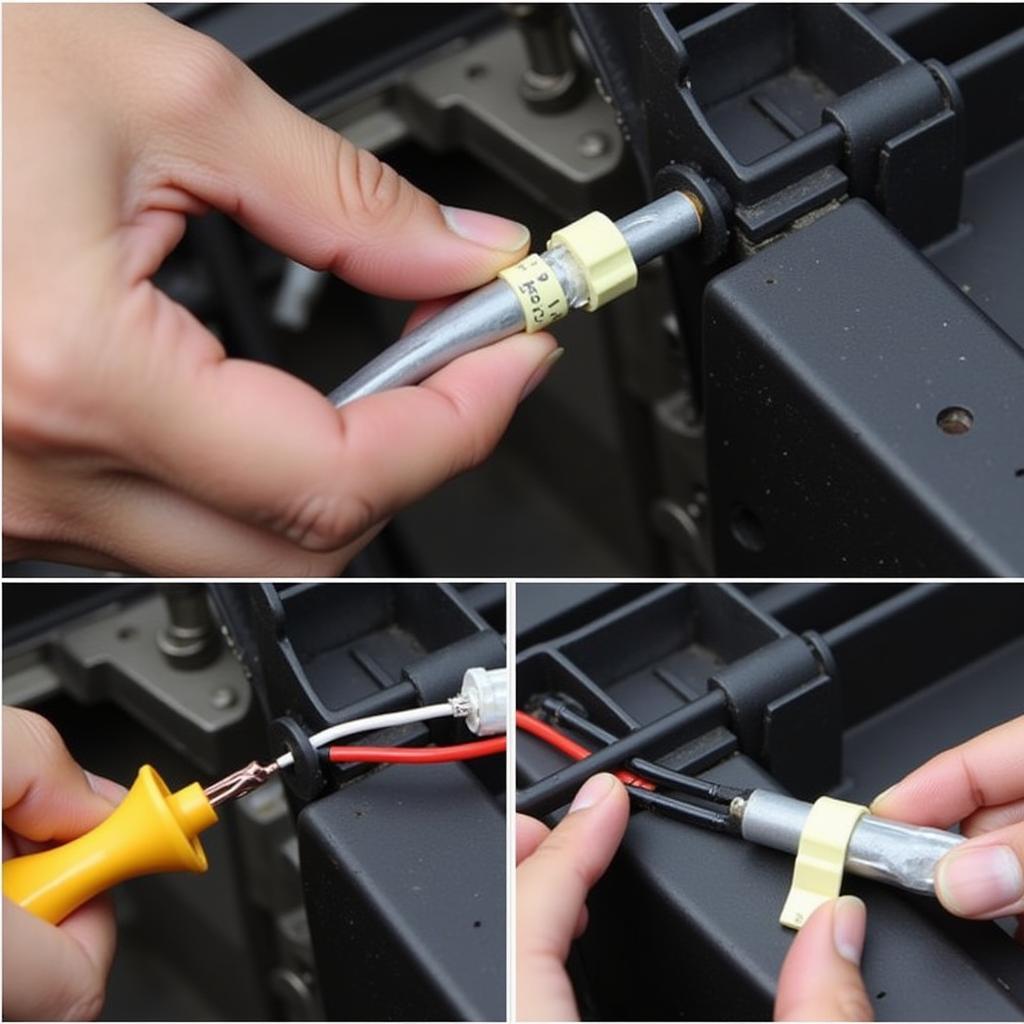A short circuit in your car can be a real headache, leaving you stranded and frustrated. Understanding how to identify and fix this common electrical issue can save you time and money. This article provides a comprehensive guide on how to troubleshoot and repair a short circuit in your car, empowering you to take control and get back on the road. Let’s dive in and demystify the process of fixing a short circuit.
Understanding Car Short Circuits
A short circuit occurs when a positive wire comes into contact with a negative wire or ground, bypassing the intended circuit. This creates a surge of current, which can blow fuses, damage wiring, and even cause a fire. Several factors can contribute to short circuits, including damaged insulation, loose connections, and faulty electrical components. Recognizing the signs of a short circuit is crucial for preventing further damage.
Common Signs of a Short Circuit
- Burning smell: A distinct burning smell, often emanating from the wiring or a specific component, is a strong indicator of a short circuit.
- Dimming or flickering lights: If your headlights or interior lights dim significantly when using another electrical component, a short circuit could be drawing excessive power.
- Blown fuses: Repeatedly blown fuses are a clear sign of a short circuit somewhere in the corresponding circuit.
- Non-functioning electrical components: If a particular electrical component suddenly stops working, a short circuit may have interrupted the flow of power.
- Overheating wires or components: Excessive heat radiating from wires or electrical components indicates a short circuit and the potential for fire.
Diagnosing the Short Circuit
Locating the source of the short circuit can be challenging but is essential for a successful repair. Start by visually inspecting the wiring harnesses for any obvious damage, such as frayed insulation or exposed wires. Check for loose connections and corroded terminals. If the fix rear light on car doesn’t solve the problem, you need to consider more complex diagnostics. Using a multimeter to test the continuity and resistance of the wiring can help pinpoint the exact location of the short. Refer to your car’s wiring diagram for guidance on the specific circuits and components involved.
Using a Multimeter for Diagnosis
- Disconnect the battery’s negative terminal: This crucial safety step prevents further damage and potential electric shock.
- Set the multimeter to continuity mode: This setting emits an audible signal when a complete circuit is detected.
- Probe the suspected wires: Touch one probe to the positive side of the circuit and the other to the negative or ground.
- Listen for the signal: A continuous beep indicates a short circuit. Move the probes along the wiring to isolate the specific location of the fault.
Repairing the Short Circuit
Once you have identified the source of the short circuit, the repair process can begin. Depending on the nature of the problem, the solution may involve repairing damaged wiring, replacing faulty components, or tightening loose connections. In some cases, simply replacing a blown fuse might suffice, but if the problem persists, further investigation is necessary. Don’t hesitate to consult a qualified mechanic if you are uncomfortable working with electrical systems or if the problem proves to be complex. You might need help with how to fix wiring in car.
“A common mistake DIYers make is failing to disconnect the battery before working on electrical systems. This can lead to further damage and even injury,” says John Miller, a seasoned automotive electrician.
 Car Wiring Repair
Car Wiring Repair
Preventing Future Short Circuits
Preventing short circuits is key to maintaining a healthy electrical system. Regularly inspect your car’s wiring for any signs of wear and tear. Ensure that all connections are secure and free from corrosion. If you are installing any aftermarket electrical accessories, ensure they are properly grounded and connected to prevent potential short circuits. Dean winchester fixing car is a great example of proactive car maintenance, although slightly exaggerated for entertainment purposes! Addressing these issues promptly can prevent costly repairs and ensure the reliable operation of your vehicle’s electrical systems. You could also learn how hard is it to fix a water damaged car since water damage can lead to shorts. And if you’re experiencing issues with your interior lights, check out this guide on how to fix a dome light in a car.
“Proper grounding is essential for preventing short circuits. Make sure all electrical components have a secure and clean ground connection,” advises Sarah Johnson, an automotive engineer.
Conclusion
Fixing a short circuit in your car might seem daunting, but with careful diagnosis and the right tools, it’s a manageable task. Remember to prioritize safety by disconnecting the battery before working on any electrical components. By understanding the signs, diagnosis procedures, and repair techniques outlined in this article, you can confidently tackle this common automotive problem and keep your car running smoothly. Don’t hesitate to contact AutoTipPro at +1 (641) 206-8880 or visit our office at 500 N St Mary’s St, San Antonio, TX 78205, United States, if you need further assistance. We are always happy to help!





Leave a Reply